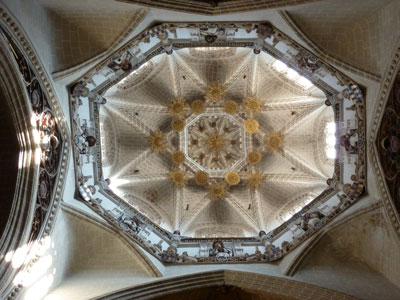Crossed-arch vaults between 10th and 16th centuries. Geometry, construction and structural behaviour
Author: Paula Fuentes
Crossed-arch vaults are a singular type of ribbed vaults. Their characteristic feature is that the ribs that form the vault are intertwined, forming polygons, and leaving an empty space in the middle, sometimes covered by a lantern. This dissertation analyses this type of vaults, from the point of view of geometry, construction and structural behaviour. The dissertation is part of the discipline of Construction History.
The study is organized in three parts. In the first part, a historic overview of crossed-arch vaults has been made for the first time, compiling the different places where they were found. They were built between the 10th to the 20th century. Not too many of the vaults survive. The dissertation covers the period between 10th to 16th century. This period goes from the Ummayad Caliphate to Late Gothic and the transition to Renaissance in Europe, and to the Timurid Dinasty in Asia.
The second part deals with the aforementioned sections: geometry, construction and structural
behaviour. Regarding geometry, the different types of layouts are analyzed in space and in horizontal projection. One of the most important aspects is the potential geometrical incompatibilities between ribs.
Regarding construction, there is not a unique construction system. This is due to the long period and large geographical spread throughout which these vaults were built. Therefore the vaults are studied according to the materials and techniques. They are classified according to the way of build the intersection between the ribs. In relation to the structural behaviour, some of the most important aspects of ribbed vaults are reviewed.
These aspects can be applied to crossed-arch vaults. The framework within the vaults are analysed is defined, that is Limit Analysis of Masonry Structures. The different works about structural behaviour of ribbed vaults are investigated. Finally, the structural analysis of the ciboria in the cathedral of Zaragoza has been carried out, as an example of a structural analysis of this type of vaults.
In the third part, two case studies have been analysed. The first are the vaults of the maqsura in the
mosque of Córdoba, built in the middle of the 10th century by caliph al-Hakam the 2nd. These are the first known crossed-arch vaults. The second case is the vault over the transept of the church of San Millán in Segovia, which is probably one of the first Christian examples. Both cases have been surveyed with a laser total station, generating a hypothesis for the geometry. Also, a study if the construction process has been made. It was only possible to visit the extrados in the Chapel of Villaviciosa (one of the vaults in Cordoba). It was measured up using measuring tape and laser distance meter. In this case, we can deduce the thickness of the vault and it has been possible to carry out a structural analysis.
Alongside these three parts, the dissertation includes some appendices such as a catalogue of the
vaults in Spain and north of Africa or maps showing the vaults in different locations (Spain, north of Africa, Europe and Asia) together with their chronology.
Fuentes, P. 2013. “Bóvedas de arcos entrecruzados entre los siglos X y XVI: geometría construcción y estabilidad”. PhD dissertation, Universidad Politécnica de Madrid.











